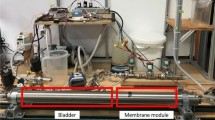Abstract
High silica content of de-inked paper mill effluents is limiting their regeneration and reuse after membrane treatments such as reverse osmosis (RO). Silica removal during softening processes is a common treatment; however, the effluent from the paper mill studied has a low hardness content, which makes the addition of magnesium compounds necessary to increase silica removal. Two soluble magnesium compounds (MgCl2∙6H2O and MgSO4∙7H2O) were tested at five dosages (250–1,500 mg/L) and different initial pH values. High removal rates (80–90 %) were obtained with both products at the highest pH tested (11.5). With these removal efficiencies, it is possible to work at high RO recoveries (75–85 %) without silica scaling. Although pH regulation significantly increased the conductivity of the waters (at pH 11.5 from 2.1 to 3.7–4.0 mS/cm), this could be partially solved by using Ca(OH)2 instead of NaOH as pH regulator (final conductivity around 3.0 mS/cm). Maximum chemical oxygen demand (COD) removal obtained with caustic soda was lower than with lime (15 vs. 30 %). Additionally, the combined use of a polyaluminum coagulant during the softening process was studied; the coagulant, however, did not significantly improve silica removal, obtaining a maximum increase of only 10 %.








Similar content being viewed by others
References
Al-Mutaz IS, Al-Anezi IA (2004) Silica removal during lime softening in water treatment plant. International Conference on Water Resources and Arid Environment, King Saud University, Riyadh, December 5–8
Al-Rehaili AM (2003) Comparative chemical clarification for silica removal from RO groundwater feed. Desalination 159:21–31
American Public Health Association (APHA), American Water Works Association (AWWA), Water Environment Federation (WEF) (2005) Standard methods for the examination of water and wastewater, 21st edn. American Public Health Association (APHA), Maryland, USA
Chen S, Chang T, Lin C (2006) Silica pretreatment for a RO brackish water source with high magnesium. Water Sci Technol Water Supply 6:179–187
Ferguson L (1992a) Deinking chemistry: part 1. Tappi J 75:75–83
Ferguson L (1992b) Deinking chemistry: part 2. Tappi J 75:49–58
Hamäläinen H, Aksela R, Rautiainen J, Sankari M, Renvall I, Paquet R (2007) Silicate-free peroxide bleaching of mechanical pulps: efficiency of polymeric stabilizers. In: Proceedings TAPPI of International Mechanical Pulping Conference, 215−236, Minneapolis, USA, May 6–9
Hater W, Kolk CZ, Dupoiron C, Braun G, Harrer T, Götz T (2011) Silica scaling on reverse osmosis membranes—investigation and new test methods. Desalin Water Treat 31:326–330
Haynes WN (ed) (2013) CRC Handbook of Chemistry and Physics, 94th edn. CRC Press, Boca Raton
Hermosilla D, Ordóñez R, Blanco L, de la Fuente E, Blanco A (2012) pH and particle structure effects on silica removal by coagulation. Chem Eng Technol 35:1632–1640
Hsu H, Chen S, Lin C, Chang T (2008) Silica pretreatment for RO membrane by softening-adsorption. J Environ Eng Manag 18:99–103
Huuha TS, Kurniawan TA, Sillanpää MET (2010) Removal of silicon from pulping whitewater using integrated treatment of chemical precipitation and evaporation. Chem Eng J 158:584–592
Koo T, Lee YJ, Sheikholeslami R (2001) Silica fouling and cleaning of reverse osmosis membranes. Desalination 139:43–56
Latour I, Miranda R, Blanco A (2013) Silica removal from newsprint mill effluents with aluminum salts. Chem Eng J 230:522–531
Negaresh E, Antony A, Cox S, Lucien FP, Richardson DE, Leslie G (2013) Evaluating the impact of recycled fiber content on effluent recycling in newsprint manufacture. Chemosphere 92:1513–1519
Ning RY (2002) Discussion of silica speciation, fouling, control and maximum reduction. Desalination 151:61–73
Ordoñez R, Hermosilla D, San Pío I, Blanco A (2010) Replacement of fresh water use by final effluent recovery in a highly optimized 100 % recovered paper mill. Water Sci Technol 62:1694–1703
Parks JL, Edwards M (2007) Boron removal via formation of magnesium silicate solids during precipitative softening. J Environ Eng 133:149–156
Salvador Cob S, Beaupin C, Nederlof MM, Harmsen DJH, Cornellisen ER, Zwijnenburg A, Genceli Güner FE, Witkamp GJ (2012) Silica and silicate precipitation as limiting factors in high-recovery reverse osmosis operations. J Membr Sci 423–424:1–10
Sheikholeslami R, Bright J (2002) Silica and metals removal by pretreatment to prevent fouling of reverse osmosis membranes. Desalination 143:255–267
Sheikholeslami R, Tan S (1999) Effects of water quality on silica fouling of desalination plants. Desalination 126:267–280
Sheikholeslami R, Al-Mutaz IS, Koo T, Young A (2001) Pretreatment and the effect of cations and anions on prevention of silica fouling. Desalination 139:83–95
Wolf V (1966) Aqueous Solutions and Body Fluids. Their concentrative properties and conversion tables. Harper & Row, New York
Zeng YB, Yang CZ, Pu WH, Zhang X (2007) Removal of silica from heavy oil wastewater to be reused in a boiler by combining magnesium and zinc compound with coagulation. Desalination 216:147–159
Acknowledgments
The authors wish to acknowledge the financial support of the European Commission through the project “AQUAFIT4USE” (ref. 211534), the Community of Madrid through the program “PROLIPAPEL II-CM” (S-2009AMB-1480), and the Spanish Ministry of Education for the doctoral grant of I. Latour (AP2009-4197). The authors would also like to thank Sachtleben Wasserchemie GmbH for supplying the coagulant used in this study and Holmen Paper Madrid for the water samples used in this work. Finally, the collaboration of Patricia García and Maria Balmaseda during the lab work is deeply acknowledged.
Author information
Authors and Affiliations
Corresponding author
Additional information
Responsible editor: Bingcai Pan
Rights and permissions
About this article
Cite this article
Latour, I., Miranda, R. & Blanco, A. Silica removal in industrial effluents with high silica content and low hardness. Environ Sci Pollut Res 21, 9832–9842 (2014). https://doi.org/10.1007/s11356-014-2906-8
Received:
Accepted:
Published:
Issue Date:
DOI: https://doi.org/10.1007/s11356-014-2906-8




